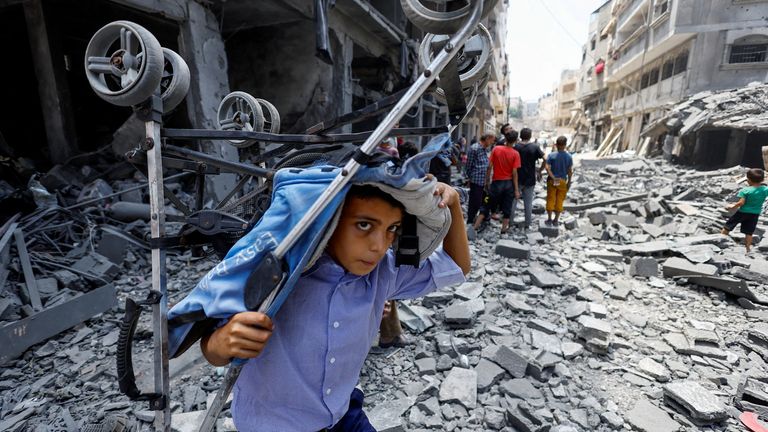When former Israeli Prime Minister Ariel Sharon executed his unilateral withdrawal plan from the Gaza Strip on September 11, 2005, the main selling point was clear: “Protecting the settlers in the Strip is too costly.” Under this plan, Israel dismantled its military bases in Gaza, withdrew all soldiers, and evacuated over 9,000 Israeli settlers from 25 settlements.
In reality, the unilateral pullout served as a calculated strategy to relocate several thousand illegal settlers from Gaza to other equally illegal settlements in the West Bank, while effectively sealing off the entire Strip from the outside world—a blockade that endures to this day.
Now, nearly two decades later, Prime Minister Benjamin Netanyahu appears to be turning back the clock, following the Israeli Security Cabinet’s decision to reoccupy Gaza. In truth, however, this move is a leap into the unknown—an unpredictable gamble at a time when the humanitarian crisis within the enclave has reached catastrophic levels, with consequences that may spiral out of control.
From a military standpoint, senior Israeli commanders have openly rejected the plan, deeming it both operationally exhausting and perilous—not only for soldiers but also for the remaining hostages still held by Hamas. Of the 251 people abducted on October 7, 2023, 50 remain in captivity.
Given that 75% of Gaza is already under Israeli control, and to avoid further political-military fractures, the likely outcome is a hybrid strategy: neither a full siege nor a complete reoccupation. Chief of Staff Eyal Zamir, who voiced strong reservations about the plan, has instead advocated for fortifying the areas already under IDF control and launching targeted strikes from those positions to wear down and exhaust Hamas. These attack lines would lie west of the buffer zone, which is currently being cleared of tunnels and Hamas infrastructure.

Zamir warned that reoccupation would erode both regular and reserve forces, drain resources, and overextend armored units, whose maintenance is already costly and logistically demanding. Military assessments suggest that fully occupying Gaza City and the central refugee camps could take years, not months, as some political leaders assume—with the longer timeline inevitably translating into higher casualties, deeper financial strain, and further deterioration of Israel’s already tarnished global image, as accusations of genocide mount.
Moreover, any attempt to seize the remainder of Gaza could result in the execution of all remaining hostages, making Netanyahu liable for an inevitable political showdown with their families. In fact, during the Cabinet meeting that approved reoccupation, Zamir urged the removal of “hostage recovery” from the official objectives, warning that Hamas would kill them the moment Israeli troops re-enter the Strip.
Reoccupation would also require calling up 250,000 reservists—a massive economic and social burden—and would drag Israel deeper into the Gaza quagmire, with the likelihood of more casualties among an already war-weary military entering its third year of sustained engagement on at least three fronts. According to Maariv, the psychological toll is intensifying, with suicide rates rising among soldiers who see no end in sight to a war that has failed to achieve any of its stated goals—neither freeing the hostages nor dismantling Hamas’s military capacity.
Another looming challenge is the question of supplying and feeding over two million displaced and unemployed Gazans—a responsibility the IDF is ill-equipped to bear. Zamir has categorically opposed assigning this burden to the military.
Domestically, the relationship between political decision-makers and the military leadership has broken down, with each side blaming the other for the hostage crisis. The generals accuse Netanyahu of assuming a prisoner exchange was imminent, thereby holding back the military from delivering a decisive blow to Hamas. Netanyahu, in turn, claims the army failed both to prevent the October 7 attack and to defeat Hamas afterward.
Adding to this internal friction is the opposition’s exploitation of Netanyahu’s crisis in a bid to collapse his coalition government—an outcome that could trigger early elections, a scenario that Israel can ill afford in its current predicament, as the political and diplomatic fallout could prove disastrous, resetting the conflict to square one.
Regionally, Egypt has categorically rejected any large-scale ground invasion of Gaza, warning that such a move would threaten Egyptian national security and could jeopardize the 1979 Camp David peace treaty. Cairo is likely to view reoccupation as an attempt to impose a new status quo in Gaza—one that “will not go unanswered” diplomatically and could prompt a reassessment of bilateral agreements with Tel Aviv.
Meanwhile, another front is simmering: Lebanon—specifically Hezbollah—which has been trying to regroup after sustaining heavy losses since October 8, 2023. The Lebanese government has recently endorsed a policy to disarm the group and place all weapons under state control. Hezbollah’s Deputy Secretary-General, Naim Qassem, has warned that if Israel intensifies operations against the movement, it will resume rocket fire into Israeli territory. For Hezbollah, the reoccupation of Gaza could provide a powerful pretext to re-enter the conflict, reshuffle the strategic deck, and improve its negotiating position—particularly now that it has little left to lose.
The American role in this equation remains opaque. President Biden has publicly opposed the reoccupation plan, yet continues to grant Israel the necessary assurances—both in arms supplies and in ready-to-use UN Security Council vetoes. Some policy circles in Washington are increasingly embracing the view that Gaza’s “next phase” begins with force, not diplomacy—treating the Strip as rebellious territory that must first be subdued militarily before being rebuilt politically and securely.
Global opposition to the plan, coupled with eroding domestic support, may ultimately force Netanyahu to abandon the illusion of reoccupation in favor of a single comprehensive deal—ending the war outright and withdrawing from most of Gaza in one stroke. This would require Hamas to be ready for such an agreement.
The lingering question is: Does Netanyahu have an exit strategy? History suggests he usually finds one—but only for himself. The deeper problem is that no one in Israel’s political or military leadership seems to have a viable plan for navigating the political, military, and humanitarian impasse. For now, everyone is simply waiting.
Dr. Hatem Sadek – Professor at Helwan University
